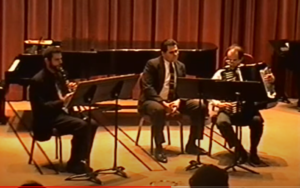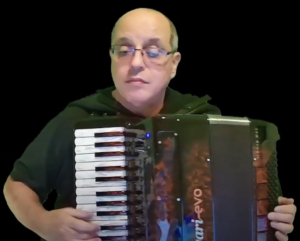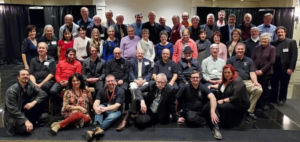In the 1870s, Giuseppe Verdi attempted to implement a formal accordion program in the Italian conservatory. The academic elite, who viewed the accordion as an unserious folk instrument, were unconvinced.
A century and a continent removed, Joseph Natoli found himself running up against the same walls. By the early 1970s, Natoli was a young world champion seeking a place to study, but no American university at that time recognized the accordion.
Undeterred, Natoli studied trumpet and piano at the Dana School of Music in Youngstown, Ohio. He then pursued his Bachelor’s and Master of Music degrees at the University of Toronto Faculty of Music, where he studied composition, theory, and electronic music. The Canadian school recognized the accordion, but Natoli pushed further, becoming the first student there to declare the free-bass accordion as his principal instrument. Unlike its more common Stradella cousin built around the circle-of-fifths, the chromatic free-bass system allows the player to create near limitless left-hand harmonic voicings and melodic runs.

Univ of Toronto 1977 Masters Electronic Music Class
(Top: Richard Bronskill, Middle LtoR: Richard Romiti, Daniel McConnachie, Joseph Natoli, Bottom: Daniel Foley)
At 19, he composed his Toccata #1. A complex piece — for 19 or any age — Natoli’s Toccata #1 is still performed at competitions, including the prestigious annual Coupe Mondiale. Acclaimed accordionist Michael Bridge chose Natoli’s Toccata #1 for his own senior recital at their shared alma mater. Natoli also performed this same Toccata #1 on his own senior recital 43 years earlier!
Toccata #1 (Joseph Natoli) – Michael Bridge performing – YouTube

Michael Bridge performing his senior recital Joseph Natoli’s Toccata #1
Natoli’s compositions can be equally playful and subversive. Homage & Offspring to the Bumblebee (Son of a Bee) was conceived as a highly technical play on Rimsky-Korsakov’s overused Flight of the Bumblebee. Polkacism, written for accordion and clarinet, is an attempt at surgically removing preconceptions about an accordion/clarinet duo.
“Polka created the stigma of accordion I wanted to avoid,” says Natoli, “I want people to understand the beauty of this instrument outside of polka.”

1997, Natoli (right) performing Polkacism with Robert Fitzer (left)
In recent years, Natoli’s compositions explore the digital accordion’s orchestral possibilities, as well as his poignant sense of melody. Christmas Prayer began as a recent class exercise and developed into a haunting piece that sounds like a whole orchestra when performed on a digital instrument. His melodic sense is woven throughout his later work, such as Conversation In the Mirror, Prayer for Humanity, and Hymn of Hope, also fully orchestrated with the digital tool.
“Maybe it’s in the musicality of the language,” Natoli observes, “but Italians seem to have an innate sense of the shape and direction of melodies and have written some of the most beautiful melodies in music. I think I inherited that trait of writing attractive and memorable melodies from my Italian ancestry, but supported quite well by meaningful and creative harmonies.”
Natoli immediately records a new piece upon completion, fusing a performance aspect into his composing process. Where a composer once had to wait until an orchestra had been assembled to hear his arrangement, the digital accordion allows a composer—arranger like Natoli to realize his vision fully as soon as the notes hit the page. Woodwinds, strings, percussion — all within the reach of the digital player’s two hands.

Natoli performing his compositions in a virtual concert in May 2022
Natoli embraces technology as a useful tool. He enjoyed a long career in IT management, and was gigging with MIDI tracks he made on a Commodore computer in the early 1980s.
As the internet era came of age in the 1990s, Natoli saw an opportunity to make a mark. In 1997, he founded JANPress Publications, an online publishing house for accordion composers, arrangers, and performers.
JANPress recently evolved from its publishing roots into education. JANPress University, currently in its inaugural class, continues to build upon and utilize digital technology, allowing students in disparate locations access to intimate study with Natoli.
Blessed with dynamic teachers in his youth, Natoli has developed into a natural teacher himself. An avid health and wellness enthusiast, he takes a holistic approach to his JANPress University accordion program. He uses the acronym LEARN to illustrate his teaching philosophy — Listen, Experiment, Apply, Repeat, Normalize.

Natoli with two of his teachers in 1975. L to R: Frank Natoli Sr (father), Joseph Macerollo (teacher), JoAnn Natoli (wife), Tito Guidotti (composer), Mickey Bilsilia (teacher), Joseph
The first lesson is how to hold the instrument, how to use the straps. A lesson on bellows technique might start with a primer on tritone substitutions and end with holistic remedies for stage fright. It all makes perfect sense. When teaching fingering, he dispels dusty orthodox in favor of a practical, methodical approach. He emphasizes dynamics and note shaping, and other techniques often ignored in traditional lessons. “Many teachers don’t know how to do it, so they don’t teach it,” he says.
As a teacher, Natoli is thorough, gracious and patient. “Learning should be fun,” he tells one class session, “If it’s not fun, you’re doing it wrong.”
A rewarding experience is when students tell him they are better accordion players after a single lesson. Natoli envisions eventual college accreditation for his course, and its incorporation into homeschool and charter school syllabi. His hope is that his students not only “become better technically and musically,” he says, “but have an appreciation for what that means.”
Natoli has dedicated the bulk of his adult life to promoting the accordion, especially the digital accordion. The culmination of this work is the GR8 IDEAS digital accordion symposium, an annual event begun in 2018, conceived as a place where “all digital accordionists can come to learn, share, and delight in their digital accordions and digital peripherals.”

2019 GR8 IDEAS 2nd Annual Symposium
“There was no home for people playing digital accordion,” Natoli observes, “Roland did not provide any kind of aftermarket support. So we provided a home and aftermarket support for digital players.”
Due to lingering economic and travel restrictions, 2023’s GR8 IDEAS 5.0 is being held virtually, featuring recurring monthly workshops throughout the year that can be accessed online and attended piecemeal. The first workshop focuses on understanding MIDI in relation to the digital accordion. (The symposium is open to acoustic players as well.)
Technology and teaching; composing, arranging, and performing — Natoli sees these as equal and overlapping impulses, driven always by altruistic motivations.
“The 2008 Roland digital competition was for my father,” he explains, “I started JANPress Publishing not for me, but for my teachers and colleagues who had been snubbed by the traditional publishing industry. GR8I DEAS was inspired to help digital players understand the technology, and to learn their instrument at an optimal level. I started JANPress University for accordion players who want to solidify and fill in the gaps of their playing. Everything I’ve done is to give back.”
For more information on JANPress University, visit www.janpressmusic.com/janpress-university or reach out to janpressmusic@yahoo.com
Note: The Happy Music Center is devoted to everything from conception to inventing, experimenting, developing cutting-edge technology, building, programming, and playing digital musical instruments. We support and recommend specialized digital workshops, symposiums, and conferences, notably The GR8IDEAS.Org https://www.gr8ideas.org/ and The International Conference on New Interfaces for Musical Expression https://www.nime.org/
Matt Powell is a writer and musician. His work explores the interconnectivity of all music and the people who create or listen. His writing has been featured in several publications, including Variety, No Depression, Emmys.com, and Angels Flight—Literary West. Learn more at
